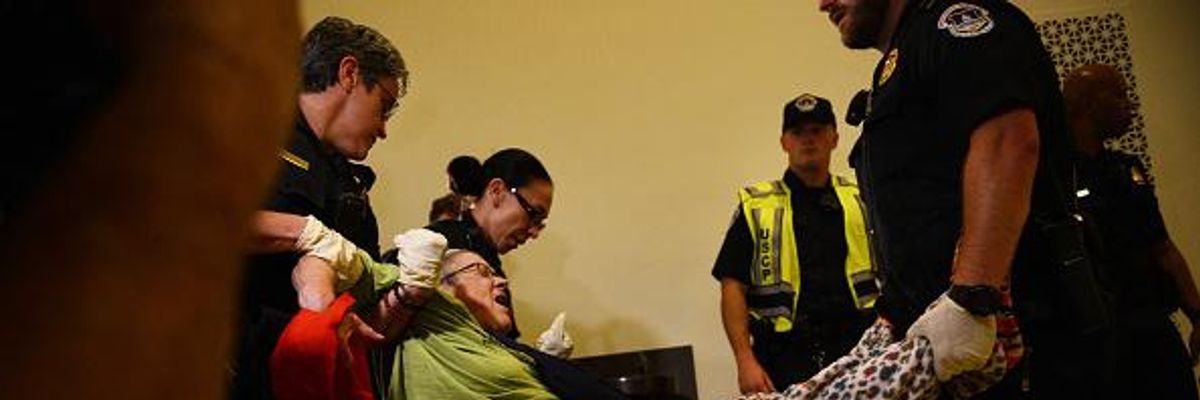Many Americans were surprised that some of the most militant responses to the proposed Republican health care plan came from disability activists - who staged a "die-in" outside the office of Senate Majority Leader Mitch McConnell in late June that resulted in at least one person being removed from her wheelchair as she was arrested. But we shouldn't be surprised: the disability rights movement has for decades employed a battery of tactics, including mass protest and civil disobedience.
The history of militant disability activism has been obscured by the glow of nostalgia that covers the Americans with Disabilities Act (ADA), which President George H.W. Bush signed twenty-six years ago this week. This year's ADA anniversary, the first since Donald J. Trump became President, is a perfect occasion to remember the movement that brought us disability civil rights in national law. With the fate of health care policy and the federal budget still uncertain, it is also a good time to recall the far-reaching agenda of that movement - which wanted far more than it ultimately got in the ADA.
"As we remember the ADA this week, Americans may be tempted to pat ourselves on the back for all the progress that has been made toward disability civil rights. But let's not congratulate ourselves too soon."
ADA and the changes it stands for often occlude the often-bitter struggle that preceded it. Post-ADA changes in areas such as transportation make it seem as though progress happened naturally. But history doesn't work that way. ADAPT, the group that led the protest outside McConnell's office, started in the 1980s as Americans Disabled for Accessible Public Transit. ADAPT protested to dramatize the argument that disabled citizens, some of whom had just won release from nursing homes, couldn't participate in the community if trains and buses were inaccessible. It is because of them and other militant fighters that ADA includes a provision requiring federally funded transportation systems to be accessible.
In addition to ADAPT, there would be no ADA without other grassroots efforts for disability rights in the 1970s and 1980s. One landmark was a campaign to force implementation of section 504 of the Rehabilitation Act of 1973, which prohibited discrimination against people with disabilities in programs receiving federal funding. Disabled activists took over the San Francisco office of the Department of Health, Education, and Welfare, demanding action from the Carter administration. This protest was the longest-ever occupation of a U.S. federal building - and it worked, thanks in part to support from the Black Panthers (including disabled members of the Panthers' Oakland chapter).
Section 504 was in itself a major federal civil rights law. The successful campaign on its behalf taught disabled people and nondisabled policymakers alike what a powerful force they could be.
Perhaps the most widely reported episode, on the very eve of the ADA, was the shut-down in 1988 of Gallaudet University by students demanding a "Deaf President Now!" Gallaudet, a university for Deaf students in Washington, D.C., has since the Civil War been a center of Deaf educational and cultural life.* But many non-Deaf policymakers didn't know this. The protests pushed the perspectives and voices of the Deaf minority onto the national stage. They encouraged members of Congress, who were already considering early versions of the legislation that ultimately became the ADA, to think more deeply about their own biases about Deafness and disability.
Although far-reaching, the ADA embodied only part of the agenda of the disability rights movement. Most important, and disappointing for many activists, the law did not define disability civil rights to include rights to economic security or adequate medical care. Only part of the slack in this area has ever been taken up by other policies, such as Supplemental Security Insurance (SSI), Social Security Disability Insurance (SSDI), and Medicaid. SSI is the federal program that that since 1974 has provided small income grants to impoverished people who are old, blind, or have other disabilities. SSDI is a work-based program that insures people in covered occupations against disabilities they develop in the course of doing their jobs. Medicaid, the federal health care program for the poor, is especially important for disabled people. All three programs have been targeted for deep cuts by the Trump administration and its allies in both houses of Congress.
For grassroots disability activists, economic security and social welfare were part and parcel of their civil rights. For example, activists in the middle twentieth century defined their rights to include access to strong trade unions that would both raise wages and give workers the power to make their jobs safer and therefore avoid injuries: The first nationally organized, cross-disability organization in U.S. history was the American Federation of the Physically Handicapped (AFPH), founded in 1940. Alongside his allies in the American Federation of Labor, AFPH president Paul Strachan sought strong unions and public policy reforms - to make the changes that might prevent disabilities and, when workers became disabled, to ensure that they could receive necessary services and continue to earn a living.
Disability activists in the years before the ADA believed their civil rights included economic security even when they could not work. The National Federation of the Blind (NFB), also founded in 1940 and still in existence, fought for full implementation of Aid to the Blind, the first federal antipoverty program for disabled adults. Under the leadership of Jacobus tenBroek, a lawyer and professor who had himself been blinded in childhood, the NFB lobbied to raise the amounts people received under Aid to the Blind and to heighten the privacy and personal autonomy enjoyed by those who participated in the program. In the 1960s, tenBroek was a leading proponent of welfare rights, by which he meant the right of every American to a basic income that would keep them out of poverty.
As we remember the ADA this week, Americans may be tempted to pat ourselves on the back for all the progress that has been made toward disability civil rights. But let's not congratulate ourselves too soon. As activists in the movement insisted in the past, full civil rights require all the protections in the ADA, plus well-funded SSI and SSDI programs, Medicaid benefits - and much more.



